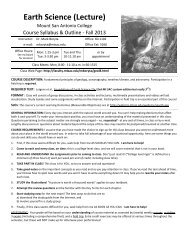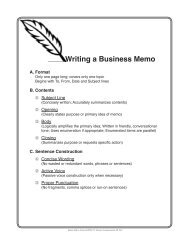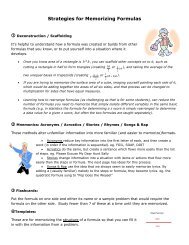STEP 1: IDENTIFY POSSIBLE MEMORIZATION STRATEGIES:
STEP 1: IDENTIFY POSSIBLE MEMORIZATION STRATEGIES:
STEP 1: IDENTIFY POSSIBLE MEMORIZATION STRATEGIES:
You also want an ePaper? Increase the reach of your titles
YUMPU automatically turns print PDFs into web optimized ePapers that Google loves.
STDY 80: Studying & Learning Name: ________________________<br />
Academic Skills: Memory Date:_________________________<br />
Memory Application Assignment<br />
Point of the Assignment: 1) To identify possible memorization strategies to try based on<br />
individual preferences and learning styles. 2) To gain practice in applying memorization<br />
techniques.<br />
<strong>STEP</strong> 1: <strong>IDENTIFY</strong> <strong>POSSIBLE</strong> <strong>MEMORIZATION</strong> <strong>STRATEGIES</strong>:<br />
Memorization Techniques:<br />
You are going to select a few memory techniques you learned in Chapter 3. As always, be sure<br />
to only select the techniques that are helpful to you. The way to decide which techniques will be<br />
most helpful to you is to use what you have discovered about your preferred learning styles.<br />
Recall what your learning style preferences and personality type are, then identify which of the<br />
20 techniques listed in the book seem like they would use that learning style. For example, an<br />
“Auditory” learner (from Three Basic Learning Styles) might want to use “Recite and Repeat,”<br />
and a “Feeler” (personality) may want to “Engage Emotions”<br />
To help you associate memory techniques to learning styles, the table listed below what looks<br />
like potential relationships between a memory technique and a learning style/personality type.<br />
Try them out and see what works.<br />
Memory Technique Learning Style / Personality Preferences<br />
Organize It (Points 1 – 3) Extraverted Thinking – ESTJ, ENTJ, ISTJ, INTJ<br />
1) Be Selective (decide what is Introverted Feeling – INFP, ISFP, ENFP, ESFP<br />
important)<br />
LSI Mode 1: Ask “Why?”<br />
2) Make It Meaningful (General<br />
to specific)<br />
INtuitives – (ENTJ, INTJ, INTP, ENTP, ENFJ, ENFP,<br />
INFJ, INFP), Mode 2- Ask “What?”<br />
3) Create Associations<br />
Extraverted iNtuition – ENFP, ENTP, INTP, INFP<br />
4) Learn Actively Kinesthetic, Artisans<br />
6) Create Pictures Visual<br />
7) Recite and Repeat Auditory, Guardians<br />
8) Write It Down Kinesthetic, Linguistic Intelligence<br />
9) Engage Your Emotions Feelers (ENFJ, ENFP, INFJ, INFP, ESFJ, ISFJ, ESFP,<br />
ISFP), Mode 1 of the LSI<br />
10) Overlearn Rationals (ENTJ, INTJ, ENTP, INTP)<br />
13) Distribute Learning (requires Judging types – ESTJ, ESFJ, ISTJ, ISFJ, ENFJ, INFJ,<br />
planning)<br />
ENTJ, INTJ<br />
©2012 Kathleen E. High 1 Rev. 4/30/12
Memory Application Assignment<br />
15) Elaborate (learn more, explain<br />
more, give more detail)<br />
Thinking Types (ESTJ, ISTJ, ISTP, ESTP, ENTJ, INTJ,<br />
ENTP, INTP)<br />
Sensory Types (ESTJ, ESTP, ISTJ, ISTP, ESFJ, ESFP,<br />
ISFJ, ISFP)<br />
Extraverted iNtuition -- ENFP, ENTP, INTP, INFP<br />
17) Remember Something Else<br />
(Something associated with it)<br />
19) Use It Or Lose It Sensing Types - ESTJ, ESFJ, ISTJ, ISFJ, ESTP, ESFP,<br />
ISTP, ISFP<br />
20) Adopt the Attitude That You<br />
Never Forget (anticipating gaining<br />
knowledge)<br />
Rationals: ENTJ, ENTP, INTJ, INTP<br />
Q-Cards<br />
Thinking Types (ESTJ, ISTJ, ISTP, ESTP, ENTJ, INTJ,<br />
ENTP, INTP) Visual, Auditory<br />
Set a Trap For Your Memory<br />
Extraverted iNtuition – ENFP, ENTP, INTP, INFP<br />
Mnemonic Devices:<br />
Linguistic Intelligence, Creative types in general, LSI<br />
New Words<br />
Mode 4, “What if…”<br />
Creating Sentences Linguistic Intelligence, Sensory Types,<br />
LSI Mode 4, “What if…”<br />
Rhymes and Songs Musical Intelligences, LSI Mode 4, “What if…”<br />
The Loci System Extraverted iNtuition – ENFP, ENTP, INTP, INFP<br />
The Peg System<br />
Visual, Logical/Mathematical Intelligence<br />
Remembering Names<br />
Extraverted Types: (ESTJ, ESTP, ESFJ, ESFP, ENFJ,<br />
ENFP, ENTJ, ENTP)<br />
<strong>STEP</strong> 2: APPLY <strong>MEMORIZATION</strong> <strong>STRATEGIES</strong>:<br />
Review Prior Learning<br />
We are now half way through the class. So far, you have learned quite a few new concepts<br />
designed to help you succeed in school. Some of the subjects you have learned about are:<br />
Three Sensory Learning Styles<br />
Motivation<br />
Maslow’s Hierarchy of Needs Theory<br />
The Five Love Languages<br />
Dream Chasers & Goal Setter’s Journey<br />
Boundaries<br />
TimeLine<br />
Puzzle Hunt<br />
Choose one of those assignments that was especially meaningful to you personally. No two<br />
people from the same group may choose the same assignment. (There are 8 from which to<br />
choose.)<br />
My Assignment to present is: ____________________________________<br />
Applying Memory Techniques<br />
You are going memorize certain aspects of that assignment and then share them orally to<br />
your group members in the next class meeting. You will use the “Memory Assignment<br />
©2012 Kathleen E. High 2 Rev. 4/30/12
Memory Application Assignment<br />
Profile” document with the individual sheet that corresponds to your topic. It gives you what<br />
information you are going to share with the class. You will not have any visual or other aids to<br />
help you recall the information, and you must be able to recite, word-for-word, THE<br />
ENTIRE text from memory. Everyone will all have a copy of that information to help you<br />
along and to see how well you do.<br />
In Chapter 3, you have learned about how to improve your memory. As you learned in the<br />
Memory Jungle, the secret to your ability to read, remember and recall information is: 1) To<br />
create a well-worn path (walk over it repeatedly), 2) Create a herd of thoughts (associate<br />
similar items), 3) Turning your back (failure to repeat it results in losing it), and 4) You are<br />
directing the traffic (You direct the herds of animals and tell them where to go).<br />
You are doing this exercise is so you can apply memorization techniques to what you have<br />
already learned in class. Remember, one of the major concepts behind memorization is<br />
repetition. The more you repeat a concept, the more likely it will stay in your long-term<br />
memory. The better path you have created to the information, the more likely you will be able to<br />
recall it – especially under stressful circumstances such as test taking and giving speeches.<br />
Another side benefit is that you will be all giving each other an opportunity to review the work<br />
we have done thus far.<br />
Keep in mind you are not required to use the techniques listed above if they are reportedly<br />
associated with one of your learning styles or personality. This list has only been provided to<br />
help students to learn how to associate memory techniques with learning styles. So be sure to<br />
make your own decision about which techniques to try.<br />
To keep things simple, try to identify no more than four memorization techniques that might<br />
potentially suit your learning styles. Then use a “trial and error” method to decide which<br />
techniques work best for you. Narrow down the list until you think you have the right amount of<br />
memorization techniques to use. You will use those techniques to help you memorize the<br />
important points behind the concept you have chosen to present.<br />
I am using the following memorization techniques to memorize my assignment. (List the<br />
heading name and the page number):<br />
______________________________________________________________________________<br />
______________________________________________________________________________<br />
How did the techniques you used affect your ability to memorize and recall the<br />
information?<br />
______________________________________________________________________________<br />
______________________________________________________________________________<br />
Test your understanding:<br />
What is the main point of this assignment?<br />
©2012 Kathleen E. High 3 Rev. 4/30/12
Memory Application Assignment<br />
______________________________________________________________________________<br />
______________________________________________________________________________<br />
Why were you expected to do this exercise?<br />
______________________________________________________________________________<br />
______________________________________________________________________________<br />
What type of person would need to do this exercise?<br />
______________________________________________________________________________<br />
______________________________________________________________________________<br />
How well do you fit the profile of the person for whom this assignment was created?<br />
______________________________________________________________________________<br />
______________________________________________________________________________<br />
Reflection: (Write down your response after completing this assignment.)<br />
______________________________________________________________________________<br />
______________________________________________________________________________<br />
©2012 Kathleen E. High 4 Rev. 4/30/12





